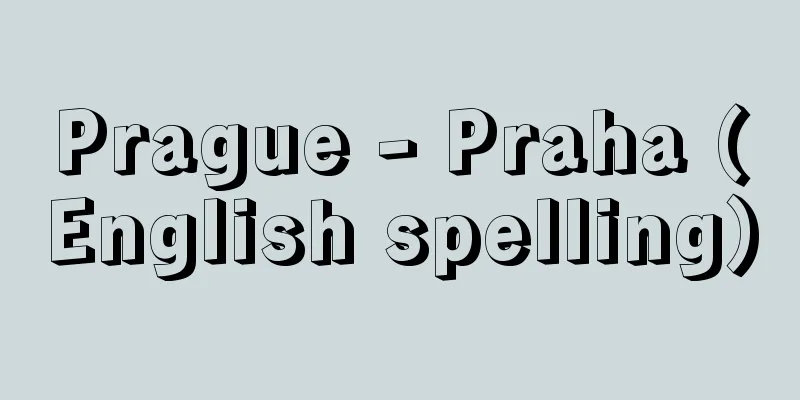Prague - Praha (English spelling)

|
The capital of the Czech Republic. It is the country's largest city and a major center of politics, economy, culture, and transportation. Its English name is Prague. It is also the center of the Central Bohemia region, and was the capital of Czechoslovakia until January 1993, when it was separated into the Czech Republic and Slovakia. It has a population of 1,178,576 (2001). The Vltava River (German name Moldau), a tributary of the Labe (German name Elbe), runs through the center of the city, and the city is formed into a basin by rolling hills. The climate is continental, with an average annual temperature of 8.0°C, -1.7°C in January, and 17.6°C in July. The annual precipitation is 502.3 mm, making it a dry city. Prague consists of the hilly areas on the left bank of the Vltava River - Hradcany (Prague Castle area) and Mala Strana (Lesser Town district) - and the areas on the right bank - Stare Mesto (Old Town), Jozehov (Jewish Quarter), and Nove Mesto (New Town), which were surrounded by the city walls until 1888, as well as the suburbs which have since expanded and been incorporated into the city. [Tsuyoshi Inano] Industry and TransportationPrague is the core of the country's commerce and industry. It is particularly important as an industrial area, and boasts about 11% of the country's total industrial production. In addition to machinery manufacturing (locomotives, automobiles, electrical engineering equipment, etc.), chemicals, textiles, and printing, the city has the largest concentration of food industries in the country, with brewing (beer, etc.), meat processing, flour milling, and frozen food manufacturing thriving. Since the 1989 regime change, tourism and service industries have been particularly remarkable. Private companies both domestic and foreign have rapidly renovated and built new downtown areas and hotels, and improved the city's landscape to accommodate the increasing number of foreign tourists visiting cultural facilities such as medieval townscapes and historical buildings. In terms of transportation, Prague is a hub for road and railway networks, and radial trunk roads and railways connect it to important Central European cities such as Vienna, Berlin, Bratislava, and Budapest. River transportation is also thriving, and the river port on the Vltava River can accommodate ships of 700 tonnes. Luzyně International Airport is located about 11 kilometers west of the city center, and the city's subway opened in 1974 and extends widely into the suburbs. [Tsuyoshi Inano] City and CultureThe foundation of today's Prague was established in the mid-14th century, when it was the capital of the Holy Roman Empire and enjoyed the name "Golden Prague". Late Gothic buildings from the 14th century and Renaissance, Baroque and Rococo buildings from the 15th to 18th centuries can be seen throughout the city center, creating a landscape worthy of being praised as the "City of a Hundred Spires" and the "Rome of the North". This historical region was registered as a World Heritage Site in 1992. The first thing that catches your eye among the historical buildings is Prague Castle, a Baroque palace that was almost completed in the 14th century and stands tall in Hradcany on the left bank. There are also many other things to see, such as the 14th century stone bridge Charles Bridge over the Vltava River, the Old Town Hall, also built in the 14th century, Tyn Church, Waldstein Palace, St. Vitus Cathedral, St. Nicholas Church, and Strahov Monastery. In addition, in the Jewish quarter (which was renamed Josefov in the late 19th century) where the novelist Kafka was born, there is a synagogue that escaped destruction even during the Nazi occupation. Educational and cultural facilities include the oldest university in Central Europe, Prague (officially known as Charles) University (1348), as well as various universities, research institutes, the National Museum, and many permanent theaters, including the National Theatre (1862), which is the fruit of the Czech national movement. Furthermore, as the home base of the world-leading Czech Philharmonic Orchestra, the city is also home to a rich selection of music halls such as the Smetana Hall and Dvorak Hall, as well as a traditional puppet theater. In the New Town is Wenceslas Square, a famous gathering place for Prague residents. [Tsuyoshi Inano] historyThe Celtic Boii people had been living in this area since the 5th century BC, but around the 6th century, Western Slavs settled there. In the 8th and 9th centuries, the foundations of Prague Castle were laid, and the fortress of Bysehrad was built to the south. The Czech dynasty of Přemysl, which emerged in the 10th century, made Prague the center of the state, worked to spread Christianity, and established a bishopric in 973. German, Latin, and Jewish merchants made Prague a trade route between Western and Eastern Europe, and by the 14th century it had developed into the economic, political, and cultural center of Europe, with a population of 40,000. In particular, Charles I of the House of Luxembourg (Holy Roman Emperor Charles IV), who became King of Bohemia (Czech Republic) in 1346, designated Prague as the capital of the empire, built the first university in Central Europe (Prague University) (1348), and invited Italian Renaissance writers such as Petrarch, bringing the Renaissance to Central Europe. He also established an archbishopric and created new urban districts, laying the foundations for present-day Prague. The Thirty Years' War, which began in 1618, broke out in Prague. Bohemian feudal nobles opposed the centralization of power in the Austrian Habsburgs and raised an army in support of the new king, the Count of the Palatinate, but were quickly defeated in the Battle of Bílá hora (German name Weissenberg) near Prague. During the Thirty Years' War, the city was overrun by the armies of various countries, losing its political importance, and from the mid-17th century onwards it declined into a Germanized provincial city. In the 18th century, the city flourished under the economic policies of the Habsburgs, manufacturing took hold, and the population reached 80,000. In the 19th century, it became one of the centers of the Slavic national movement, and the Slavic National Congress was held there during the revolution of 1848. At the time, two-thirds of the population were German, but in the latter half of the 19th century, it was one of the most industrially developed cities in the Austrian Empire, and with the power of ethnic capital, the Czech citizenry gradually gained power, becoming the center of the labor movement and the anti-German nationalist movement. On October 28, 1918, the founding of the Czechoslovak Republic was proclaimed here, and it became its capital. In 1939, Prague was occupied by German troops, and continued to be occupied until it was liberated by the Soviet army in 1945. In 1968, the so-called "Prague Spring" liberalization movement was born here. After that, it started anew as the capital of the Czech Socialist Republic within the Czechoslovak Socialist Federal Republic, which was established in 1969. In 1989, the "Eastern European Revolution" broke out, and efforts were made to move away from socialism, but the mass movement promoting political change was first organized and expanded in Prague, and spread to other areas. On January 1, 1993, the Czech Republic and Slovakia separated and became independent, and as a result, two countries were born, and Prague became the capital of the Czech Republic. [Tsuyoshi Inano] "The Face of Prague Janus," edited by Hirata Tatsuji and Hirano Yoshihiko (1986, Kokusho Kankokai)" ▽ "The Magic Empire: Rudolf II and His World," written by Robert J.W. Evans and translated by Nakano Haruo (1988, Heibonsha)" ▽ "The Vision of Prague: A Tale of the Ancient Capital of Eastern Europe," written by Vlasta Čihakova (1993, Shinjuku Shobo)" ▽ "The Heretics of Prague," written by Satsuma Hideto (1998, Gendaishokan)" ▽ "The History of Danube Europe," edited by Minamizuka Shingo (1999, Yamakawa Publishing) [References] | | | | | | | | |A stone bridge over the Moldau (Vltava) River, known for Smetana's symphonic poem "My Country." It is a representative bridge of the ancient city of Prague, and is counted among the most famous bridges in Europe. The balustrade is decorated with statues of 30 saints. Part of the World Heritage Site "Historic Center of Prague" (Czech Republic, registered in 1992) Prague, Czech Republic ©Masashi Tanaka "> Charles Bridge It is installed on the south side of the tower of the Old Town Hall, which was built in 1338. The complex dial is based on the geocentric theory, and the mechanism in which the figures of the twelve apostles appear every hour is popular. Part of the World Heritage Site "Historic Center of Prague" (Czech Republic, registered in 1992) Czech Republic, Prague ©Shogakukan "> Prague Astronomical Clock Source: Shogakukan Encyclopedia Nipponica About Encyclopedia Nipponica Information | Legend |
|
チェコ共和国の首都。同国最大の都市で政治、経済、文化、交通の一大中心地。英語名プラーグPrague。中央ボヘミア地方の中心でもあり、1993年1月にチェコとスロバキアに分離するまではチェコスロバキアの首都。人口117万8576(2001)。ラベ(ドイツ語名エルベ)川の支流ブルタバ(ドイツ語名モルダウ)川が市の中心を貫流し、起伏の多い丘陵地によって盆地が形成されている。気候は大陸性で、年平均気温8.0℃、1月は零下1.7℃、7月は17.6℃。年降水量は502.3ミリメートルと乾燥している。プラハは、ブルタバ川左岸の丘陵地フラッチャニ(プラハ城区域)とマラー・ストラナ(小市区)、右岸のスタレー・ムニェスト(旧市街)、ヨゼホフ(ユダヤ人街)、ノベー・ムニェスト(新市街)という1888年まで市壁に囲まれた区域を中心に、その後、膨張して市域に編入された郊外からなる。 [稲野 強] 産業・交通プラハはこの国の商工業の中核をなしている。ことに工業地帯として重要で、国全体の約11%の工業生産量を誇り、機関車、自動車、電気工学機器などの機械製造、化学、繊維、印刷業のほか、食品工業ではこの国最大の集中度を示し、ビールなどの醸造、食肉加工、製粉業、さらに冷凍食品業が盛んである。また1989年の体制変革以降とくに目覚ましいのは観光・サービス業である。国内外の私企業によって繁華街、ホテルなどの改造、新築、また市の景観の整備が急速に進められ、中世的な町並み、歴史的建造物などの文化施設を訪れる外国人観光客の増加に対応している。交通では、プラハは道路網、鉄道網の拠点であり、放射線状に走る幹線道路と鉄道は、ウィーン、ベルリン、ブラチスラバ、ブダペストなど中欧の重要都市との間を結ぶ。一方、河川交通も盛んで、ブルタバ川に面した河港では700トン級の船の出入が可能である。また、市の中心部から約11キロメートル西方にはルジニェ国際空港があり、市内には1974年に地下鉄が開通し、郊外に広く延びている。 [稲野 強] 市街・文化今日のプラハの基礎は神聖ローマ帝国の帝都であり、「黄金のプラハ」の名をほしいままにした14世紀なかばに築かれた。14世紀の後期ゴシック様式の建造物と、15~18世紀のルネサンス、バロック、ロココ、各様式の建造物が市の中心の至る所でみられ、「百塔の町」「北のローマ」と賛美されるのにふさわしい景観を示している。この歴史的地域は1992年に世界遺産の文化遺産(世界文化遺産)に登録された。歴史的建造物には、14世紀にほぼ完成し、左岸のフラッチャニにそびえたつバロック式宮殿のプラハ城がまず目をひかれる。さらにブルタバ川に架かる14世紀の石橋カレル橋、やはり14世紀建造の旧市庁舎、ティーン教会、ワルトシュテイン宮殿、聖ビート大聖堂、聖ミクラーシュ教会、ストラホフ修道院などみるべきものが数多くある。また、小説家カフカが生まれたユダヤ人街(19世紀後半よりヨゼホフと改名された)には、ナチス・ドイツ占領下でも破壊を免れたシナゴーグ(会堂)がある。教育・文化施設には中欧最古のプラハ(正称カレル)大学(1348)をはじめ各種大学、研究機関や国立博物館、チェコ民族運動の成果である国民劇場(1862)など多数の常設劇場があり、さらに世界有数のチェコ・フィルハーモニー管弦楽団の根拠地にふさわしく、スメタナ・ホール、ドボルザーク・ホールなどの音楽ホールや伝統的な人形劇場なども充実している。新市街にはプラハ市民の集まる場所として有名なバーツラフ広場がある。 [稲野 強] 歴史紀元前5世紀ごろからケルト系のボイイ人がこの地域に居住していたが、6世紀ごろには西スラブ人が定住した。8~9世紀にはプラハ城の基礎がつくられ、南方に城砦(じょうさい)ビシェフラトが築かれた。10世紀に出たチェコ人の民族王朝プシェミスル家は国家の中心をプラハに置き、キリスト教の普及に努め、973年には司教座を置いた。ドイツ人、ラテン民族、ユダヤ人商人によって西欧と東欧の通商路となり、14世紀にはヨーロッパの経済、政治、文化の中心地に発展して人口は4万人を数えた。ことに、1346年ボヘミア(チェコ)王となったルクセンブルク家のカレル1世(神聖ローマ=ドイツ皇帝カール4世)はプラハを帝国の首都と定め、中欧最初の大学(プラハ大学)を建て(1348)、ペトラルカなどのイタリア・ルネサンスの文人を招き、中欧のルネサンスを招来した。さらに大司教座を置き、新しい市街区を設けるなど、今日のプラハの基礎をつくった。1618年に始まる三十年戦争はプラハで勃発(ぼっぱつ)した。ボヘミアの封建貴族はオーストリア・ハプスブルク家の中央集権化に反対し、新国王にプファルツ伯を擁して挙兵したが、プラハ近郊のビーラー・ホラ(白山)Bílá hora(ドイツ語名ワイセルベルクWeißenberg)の戦いでたちまち敗れた。三十年戦争期間中、この町は各国の軍隊に蹂躙(じゅうりん)されるところとなり、政治的重要性を失い、17世紀なかば以降はドイツ化された一地方都市に衰微した。18世紀に入るとハプスブルク家の経済政策のもとで活況を呈し、マニュファクチュアがおこり、人口は8万に達した。19世紀にはスラブ民族運動の中心の一つになり、1848年革命期にはスラブ民族会議が開かれた。当時住民の3分の2はドイツ人であったが、19世紀後半はオーストリア帝国内でもっとも工業の発達した都市の一つであり、民族資本の力を背景にチェコ人市民層も徐々に勢力を増すとともに、労働運動、反ドイツ民族運動の中心となった。1918年10月28日、この地でチェコスロバキア共和国の創立が宣言され、首都となった。39年にプラハはドイツ軍によって占領され、45年に旧ソ連軍に解放されるまで続いた。68年にいわゆる「プラハの春」という自由化運動がこの地から生まれた。その後、69年に成立したチェコスロバキア社会主義連邦共和国内のチェコ社会主義共和国の首都として再出発した。89年に「東欧革命」が勃発し、脱社会主義体制化が図られたが、政治変革を推進する大衆運動はまずプラハで組織・拡大され、各地に波及した。93年1月1日にチェコとスロバキアが分離・独立を果たし、2国が誕生した結果、プラハはチェコ共和国の首都となった。 [稲野 強] 『平田達治・平野嘉彦編『プラハ・ヤヌスの相貌』(1986・国書刊行会)』▽『ロバート・J・W・エヴァンズ著・中野春夫訳『魔術の帝国――ルドルフ二世とその世界』(1988・平凡社)』▽『ヴラスタ・チハーコヴァー著『プラハ幻影――東欧古都物語』(1993・新宿書房)』▽『薩摩秀登著『プラハの異端者たち』(1998・現代書館)』▽『南塚信吾編『ドナウ・ヨーロッパ史』(1999・山川出版社)』 [参照項目] | | | | | | | | |スメタナの交響詩『わが祖国』で知られるモルダウ川(ブルタバ川)に架かる石造の橋。古都プラハを代表する橋で、ヨーロッパにおける名橋の一つにも数えられる。欄干には30の聖人像が飾られている。世界文化遺産「プラハ歴史地区」の一部(チェコ・1992年登録) チェコ プラハ©Masashi Tanaka"> カレル橋 1338年に建設された旧市庁舎の塔の南面に設置されている。複雑な文字盤は天動説に基づき、毎時、十二使徒の人形が現れる仕掛けが人気となっている。世界文化遺産「プラハ歴史地区」の一部(チェコ・1992年登録) チェコ プラハ©Shogakukan"> プラハ旧市庁舎の天文時計 出典 小学館 日本大百科全書(ニッポニカ)日本大百科全書(ニッポニカ)について 情報 | 凡例 |
<<: Prabhākara - Prabhākara (English spelling)
Recommend
Involvement characteristics
… Around the time of his 1936 academic journal ar...
Münchner Beobachter (English spelling)
...means "observer of the nation." Its ...
Letter of indenture - Kajo
〘 noun 〙 ("Kan" means sincerity. The &qu...
Sodnom, D. (English spelling) SodnomD
…Official name = MongoliaMongol ulusArea = 1,566,...
Nonaqueous solvent
In a broad sense, it refers to all solvents other ...
Etruria (English spelling)
An area inhabited by the Etruscans, who are said t...
Cybernetics - Cybernetics
A scientific theory proposed by the American math...
Inch - Inch (English spelling)
A unit of length in the imperial system. Its symb...
Fist - Kin
Also written as kei, it is also called keisu (鏧) k...
Pawpaw - Popo (English spelling) Pawpaw
A deciduous tall tree of the Annonaceae family, pa...
《Flower Mokuran》 - Kamokuran
…The Mulan Poem in the Ancient and Modern Music R...
Thermal equator
A line of longitude that connects the points on t...
Machaerina rubiginosa (English name) Machaerinarubiginosa
...The basic variety is widely distributed in the...
Stereoselectivity - stereoselectivity
When stereoisomeric reactants give stereoisomeric ...
Aleatorik
…Music that incorporates chance into its composit...









